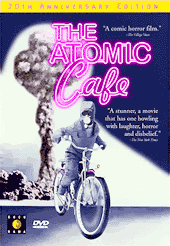Revolution #67, October 29, 2006
Check It Out: The Atomic Cafe
 |
I recently rented the DVD of The Atomic Cafe. This 1982 movie by Kevin Rafferty, Jayne Loader, and Pierce Rafferty shows the U.S. government’s bizarre, almost gleeful, celebration of nuclear war. The movie is entirely documentary footage—news reports and speeches from government officials, U.S. military training and propaganda films, and catchy 1950s music. The footage spans the first atomic bomb tests in 1945 up until just before the Cuban Missile Crisis.
This movie came out during the Cold War era, when my parents were kids. And people who grew up then have described to me having nightmares of a nuclear attack and going through bomb drills at school. I remember being taught in school about the “heroic and necessary U.S. bombing of Japan to end WW2.” We didn’t learn about the real horror of the U.S. nuclear attacks on Japan or what the U.S. was prepared to unleash on the world in the Cold War era.
What my generation has seen is George Bush’s talk of the “War on Terror” and a “battle for civilization,” ranting about the nuclear threat of other countries. But the only country in the history of the world so far that has ever used a nuclear weapon is the United States. Today, the Bush Regime asserts that it will decide what countries in the world can make, test, or use nuclear weapons. The logic here is that whatever the U.S. does, even using nuclear weapons and bombs, is justified, while other countries targeted by the U.S. as part of the “axis of evil” have no right to defend themselves.
This film gives some historical perspective on the United States’s role as the biggest and most dangerous nuclear power in the world. Newsreels, political speeches, and official propaganda show the US glorifying the use of nuclear bombs. We hear military officials and members of the Air Force describing the beauty and thrill of a nuclear explosion. The filmmakers then juxtapose this with images of the utter suffering and destruction caused by the bombing of Hiroshima and Nagasaki.
There’s many a jaw dropping moment in the film, such as President Harry Truman’s statement about the decision to drop nuclear bombs on Japan: “We thank god that it has come to us instead of to our enemies, and we pray that He may guide us to use it in His way and for His purposes.” Or a news show with U.S. Senator James E. Van Sant calling for nuclear attacks not only in several cities in North Korea, but the Chinese region of Manchuria as well. He says the U.S. could “destroy” and “contaminate” “targets” in North Korea.
We see how the U.S. used the Marshall Islands in the Pacific, in particular Bikini Island, to conduct what amounted to 67 nuclear tests between 1946 and 1958 (American Journal of Health). Islanders who were exposed to exceptionally high doses of radiation and transported and inspected by the U.S. military are shown with skin discoloration and hair loss. We hear a reporter explain there is no further damage, other than diseases which may be contracted in the future. Today, some 50 years later, there are still reports throughout the Marshall Islands of stillbirths and miscarriages, as well as high cancer rates, directly due to radiation. The Atomic Cafe shows 1950s soldiers participating in test explosions in Nevada. A propaganda film assures their safety from radiation. The soldiers wear radiation “badges” that determine whether or not they “received a lethal dose,” as one reporter describes it.
The Atomic Cafe shows U.S. government propaganda films trying to whip up Cold War hysteria by dramatizing a nuclear attack on the U.S., in a blithesome 1950s style. We see classrooms full of children doing “duck and cover” drills, preparing to dive under their desks in the event of a flashing nuclear explosion. Other films urged every family to construct a basement bomb shelter. One report shows a boy pedaling awkwardly on his bike in a full body radiation suit with dark goggles that make him look like a space alien.
Such images are harrowing. And at the same time, what’s revealed is the United States as a bloodthirsty nuclear power, ready to attack anyone that challenges them—something very relevant to understanding the current world situation. Today, the U.S., with the greatest military might, the largest number of weapons of mass destruction, still threatens the world.
The Atomic Cafe is eye-opening, disturbing, and relevant. Check it out.
If you like this article, subscribe, donate to and sustain Revolution newspaper.



